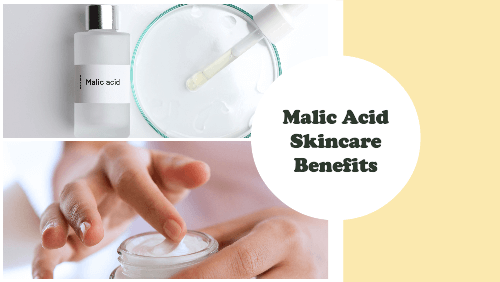If you have ever bitten into a green apple and noticed its tart taste, you’ve experienced malic acid, but this substance isn’t just for flavoring. In skincare, malic acid, derived from the Latin word ‘malum’ meaning apple, is a common and beneficial ingredient. I’m going to explain what makes malic acid a must-know for your skincare routine.
The Science of Skin Renewal: How Malic Acid Works
Malic acid is a member of the alpha hydroxy acids (AHAs) family, celebrated for stimulating exfoliation by disrupting how skin cells adhere to each other.
It’s more than just a name on the ingredient list; it plays a pivotal role in skin renewal, hydration, and evening out skin tone.
If you’re curious about the science, here’s how it works: malic acid acts like a glue dissolver between dead skin cells, encouraging their removal and making way for new, radiant skin.
Beyond Exfoliation: The Multitasking Benefits of Malic Acid
Now, this isn’t just about getting rid of old skin cells. Malic acid brings a plethora of benefits to the table, or rather, to the skin.
Not only does it quench thirsty skin by enhancing hydration, but it also works to refine skin texture and sinks deep down to reduce the appearance of fine lines and wrinkles. Think of it as a multitasker in your skincare line-up, addressing several issues at once.
A Universal Skincare Solution: Malic Acid for All Skin Types
Considering its gentleness and effectiveness, malic acid fits the bill for a wide range of skin types and struggles. Whether you’re dealing with premature aging, uneven skin pigmentation, acne, or simply dry skin, malic acid can be a game-changer.
After all, such universal appeal is what makes this ingredient stand out in the beauty world.
Diving Deeper: How Malic Acid Specifically Targets Skin Conditions
You’re going to find out about the targeted benefits malic acid brings to the table for common skin issues. This isn’t just about basic skincare; it’s also about addressing specific concerns that can truly transform your skin’s health and appearance.
1. Malic Acid: A Game-Changer for Acne-Prone Skin
Acne is a troublesome condition for many, but guess what? Malic acid is here to help. It takes charge by exfoliating the skin, reducing dead skin cell buildup, and unclogging pores.
These actions create a less hospitable environment for acne-causing bacteria, which can help prevent breakouts from occurring in the first place.
2. Fine Lines and Wrinkles (Anti-aging Benefits): The Collagen Connection
Now, for tackling fine lines, we’re looking at malic acid’s ability to promote collagen production.
Collagen is like the skin’s scaffolding, giving it structure and firmness. Regular use of malic acid can actually thicken the skin, leading to a reduction in the appearance of wrinkles and an overall more youthful look.
3. Brightening Effects on Hyperpigmentation and Acne Scarring
Hyperpigmentation and acne scarring can also take a hit from malic acid’s skin-brightening effects.
By speeding up cell turnover, malic acid helps fade dark spots and scars, leading to a more even complexion. That’s the strategy I like to leverage for a spotless, radiant skin.
4. Beyond the Surface: Malic Acid’s Potential in Overall Well-being
In my opinion, malic acid’s utility doesn’t stop at the skin’s surface.
Some research points to its potential in helping alleviate fibromyalgia symptoms, which include unexplained widespread pain.
Although this isn’t directly a skincare benefit, the importance of overall well-being plays a substantial role in skin health.
Synergistic Pairings: Malic Acid and Other Active Ingredients
Malic acid pairs superbly with other active ingredients.
This cooperative ability enhances the exfoliating effects and can enhance the skin benefits of other power players like Vitamin C and Hyaluronic Acid. It’s all about finding the right combos to deliver a skincare punch without going overboard.
I really hope that, as we sift through these insights, you’re getting excited about the prospects of malic acid as part of your skincare routine.
Stick around, because next, I’ll be diving into how to navigate through potential side effects to using malic acid both effectively and safely.
Using Malic Acid Safely: Navigating Through Potential Side Effects
Like any active ingredient, malic acid does come with its caveats.
Common side effects include;
- redness,
- itching,
- and increased sensitivity to sunlight, particularly UVB rays.
Don’t worry too much about these if you’re cautious.
Start by doing a patch test: That means applying a small amount of the product to a discreet area of skin to see how it reacts before you commit to full facial application.
Adjusting to Your Skin’s Tolerance: Understanding your skin’s tolerance is key. If you notice any adverse reactions, you can always adjust your approach down the road.
This might mean decreasing the frequency of malic acid application or seeking out formulations with lower concentrations.
Combining Malic Acid with Other Skincare Ingredients; When it comes to combining malic acid with other skincare ingredients, choose something that resonates with your skin’s needs.
It generally works well with hydrating ingredients and other acids, but using it with potentially harsh companions like retinoids might be overkill for your skin.
Gradual Introduction for Maximum Benefits: Remember, adopting a gradual approach when introducing malic acid to your skincare regime can offer a bounty of benefits without significant irritation.
Your first attempt doesn’t need to be your last, and you can always fine-tune as you go along to achieve the best results for your specific skin condition.
Sharing Your Malic Acid Experience
I really hope that you’ve found this guide to malic acid helpful. If you’re considering adding this wonder AHA to your skincare routine, keep these pointers in mind to harness its benefits safely. And if you’ve had an experience with malic acid – good or bad, I’d love to hear your feedback, so drop a comment!
